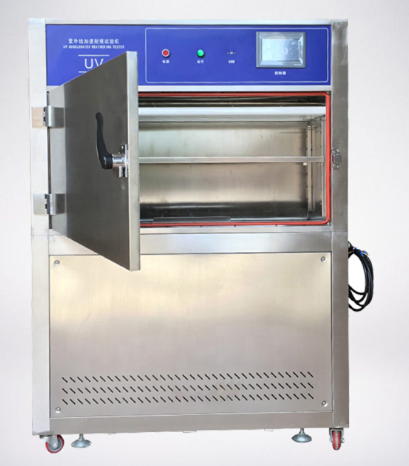Fluorescent UV aging test chamber amplitude method:
The ultraviolet rays in sunlight are the main factor causing damage to the durability performance of most materials. We use ultraviolet lamps to simulate the shortwave ultraviolet part of sunlight, which generates very little visible or infrared spectral energy. We can choose UV lamps with different wavelengths according to different testing requirements, as each lamp has different total UV irradiation energy and wavelength. Usually, UV lamps can be divided into two types: UVA and UVB.

Fluorescent UV aging test box rain test method:
For some applications, water spraying can better simulate the environmental conditions of final use. Water spraying is very effective in simulating thermal shock or mechanical erosion caused by temperature fluctuations and rainwater erosion. Under certain practical application conditions, such as sunlight, when the accumulated heat rapidly dissipates due to sudden showers, the temperature of the material will undergo a sharp change, resulting in thermal shock, which is a test for many materials. The water spray of HT-UV can simulate thermal shock and/or stress corrosion. The spray system has 12 nozzles, with 4 on each side of the testing room; The sprinkler system can run for a few minutes and then shut down. This short-term water spray can quickly cool the sample and create conditions for thermal shock.
Fluorescent UV aging test chamber wet condensation environment method:
In many outdoor environments, materials can be damp for up to 12 hours per day. Research has shown that the main factor causing outdoor humidity is dew, not rainwater. HT-UV simulates outdoor moisture erosion through its unique condensation function. During the condensation cycle during the experiment, the water in the bottom reservoir of the testing room is heated to generate hot steam, which fills the entire testing room. The hot steam maintains the relative humidity of the testing room at 100% and maintains a relatively high temperature. The sample is fixed on the side wall of the testing room, so that the test surface of the sample is exposed to the ambient air inside the testing room. The exposure of the outer side of the sample to the natural environment has a cooling effect, resulting in a temperature difference between the inner and outer surfaces of the sample. The appearance of this temperature difference causes the test surface of the sample to always have liquid water generated by condensation throughout the entire condensation cycle.
Due to outdoor exposure to moisture for up to ten hours per day, a typical condensation cycle usually lasts for several hours. HT-UV provides two methods for simulating humidity. The most commonly used method is condensation, which is th
Post time: Dec-11-2023

